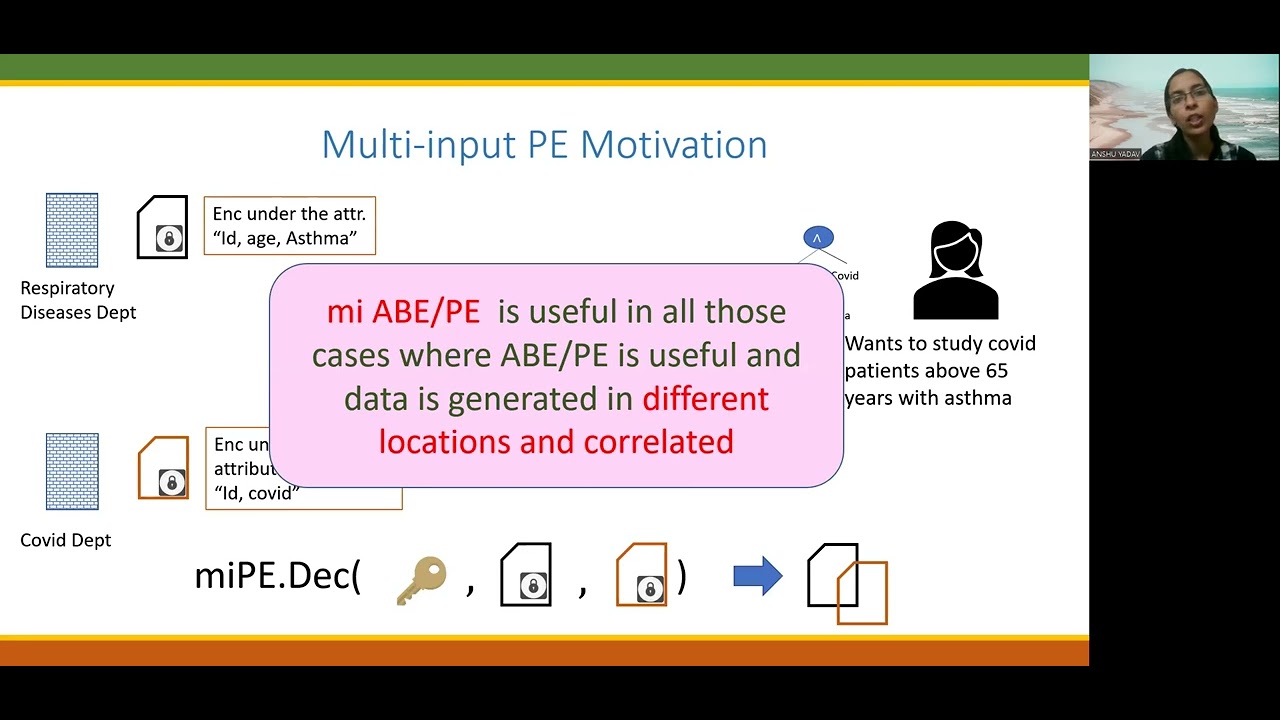Welcome to the resource topic for 2022/1024
Title:
Multi-Input Attribute Based Encryption and Predicate Encryption
Authors: Shweta Agrawal, Anshu Yadav, Shota Yamada
Abstract:Motivated by several new and natural applications, we initiate the study of multi-input predicate encryption ({\sf miPE}) and further develop multi-input attribute based encryption ({\sf miABE}). Our contributions are:
-
Formalizing Security: We provide definitions for {\sf miABE} and {\sf miPE} in the {symmetric} key setting and formalize security in the standard indistinguishability (IND) paradigm, against unbounded collusions.
-
Two-input {\sf ABE} for {\sf NC}_1 from {\sf LWE} and Pairings: We provide the first constructions for two-input key-policy {\sf ABE} for {\sf NC}_1 from {\sf LWE} and pairings. Our construction leverages a surprising connection between techniques recently developed by Agrawal and Yamada (Eurocrypt, 2020) in the context of succinct single-input ciphertext-policy {\sf ABE}, to the seemingly unrelated problem of two-input key-policy {\sf ABE}. Similarly to Agrawal-Yamada, our construction is proven secure in the bilinear generic group model. By leveraging inner product functional encryption and using (a variant of) the KOALA knowledge assumption, we obtain a construction in the standard model analogously to Agrawal, Wichs and Yamada (TCC, 2020).
-
Heuristic two-input {\sf ABE} for {\sf P} from Lattices: We show that techniques developed for succinct single-input ciphertext-policy {\sf ABE} by Brakerski and Vaikuntanathan (ITCS 2022) can also be seen from the lens of {\sf miABE} and obtain the first two-input key-policy {\sf ABE} from lattices for {\sf P}.
-
Heuristic three-input {\sf ABE} and {\sf PE} for {\sf NC}_1 from Pairings and Lattices: We obtain the first three-input {\sf ABE} for {\sf NC}_1 by harnessing the powers of both the Agrawal-Yamada and the Brakerski-Vaikuntanathan constructions.
-
Multi-input {\sf ABE} to multi-input {\sf PE} via Lockable Obfuscation: We provide a generic compiler that lifts multi-input {\sf ABE} to multi-input {\sf PE} by relying on the hiding properties of Lockable Obfuscation ({\sf LO}) by Wichs-Zirdelis and Goyal-Koppula-Waters (FOCS 2018), which can be based on {\sf LWE}. Our compiler generalizes such a compiler for single-input setting to the much more challenging setting of multiple inputs. By instantiating our compiler with our new two and three-input {\sf ABE} schemes, we obtain the first constructions of two and three-input {\sf PE} schemes.
Our constructions of multi-input {\sf ABE} provide the first improvement to the compression factor of non-trivially exponentially efficient Witness Encryption defined by Brakerski et al. (SCN 2018) without relying on compact functional encryption or indistinguishability obfuscation. We believe that the unexpected connection between succinct single-input ciphertext-policy {\sf ABE} and multi-input key-policy {\sf ABE} may lead to a new pathway for witness encryption.
ePrint: https://eprint.iacr.org/2022/1024
Talk: https://www.youtube.com/watch?v=qMzXGw-urFs
Slides: https://iacr.org/submit/files/slides/2022/crypto/crypto2022/313/slides.pdf
See all topics related to this paper.
Feel free to post resources that are related to this paper below.
Example resources include: implementations, explanation materials, talks, slides, links to previous discussions on other websites.
For more information, see the rules for Resource Topics .
